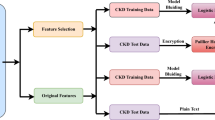Abstract
In general, medical pattern is a collection of characters formed using the characters such as ‘a’, ‘c’, ‘g’ and ‘t’. The length of the pattern varies from one disease to another disease, and the pattern also seems to be different for different patients. Identifying an unusual pattern from the information design is troublesome a decade ago. In this paper, with a specific end goal to enhance the precision of the anomalous distinguishing pattern, an Artificial Immune System (AIS) is framed. In the present study, AIS is used to obtain the abnormal pattern by learning the characteristics of the entire data set. Due to the powerful and adaptive nature of AIS, detecting and identifying abnormal pattern is more accurate. This proposed idea is implemented in MATLAB software and experimented on DNA/RNA dataset and the performance is verified.







Similar content being viewed by others
References
Hulshizer R, Blalock EM (2007) Post hoc pattern matching: assigning significance to statistically defined expression patterns in single channel microarray data. BMC Bioinform 8:240
Perelman S, Mazzella MA, Muschietti J, Zhu T, Casal JJ (2003) Finding unexpected patterns in microarray data. Plant Physiol 133(4):1717–1725
Valafar F (2002) Pattern recognition techniques in microarray data analysis: a survey. Ann NY Acad Sci 980:41–64
Stekel D (2006) Microarray bioinformatics. Cambridge University Press, Cambridge
Ben-Dor A, Shamir R, Yakhini Z (1999) Clustering gene expression patterns. J Comput Biol 6(3–4):281–297
Eisen M, Spellman P, Brown P, Botstein D (1998) Cluster analysis and display of genome-wide expression patterns. Proc Natl Acad Sci 95:863–868
Jiang D, Tang C, Zhang A (2003) Cluster analysis for gene expression data: a survey. www.cse.buffalo.edu/DBGROUP/bioinformatics/papers/survey (2003)
Bohern BF, Hanley EN Jr (1995) Extracting knowledge from large medical databases: an automated approach. Comput Biomed Res 28:191–210
Altschul SF, Miller W (1990) Basic local alignment search tool. J Mol Biol 215:403–410
Iyer VR (1999) The transcriptional program in the response of human fibroblasts to serum”. Science 283:83–87
Eisen MB et al (1998) Cluster analysis and display of genome-wide expression patterns. Proc Natl Acad Sci USA 95(25):14863–14868
Tavazoie S (1999) Systematic determination of genetic network architecture. Nature Genet 22:281–285
Tamayo P (1999) Interpreting patterns of gene expression with self-organizing maps: methods and application to hematopoietic differentiation. Proc Natl Acad Sci USA 96(6):2907–2912
Alon U (1999) Broad patterns of gene expression revealed by clustering analysis of tumor and normal colon tissues probed by oligonucleotide array. Proc Natl Acad Sci USA 96(12):6745–6750
Ben-Dor A, Shamir R, Yakhini Z (1999) Clustering gene expression patterns. J Comput Biol 6(3/4):281–297
De Smet Frank (2002) Adaptive quality-based clustering of gene expression profiles. Bioinformatics 18:735–746
Cavallaro S, D’Agata V, Manickam P, Dufour F, Alkon DL (2002) Memory specific temporal profiles of gene expression in the hippocampus. Proc Natl Acad Sci USA 99(25):16279–16284
Pavlidis P, Noble WS (2001) Analysis of strain and regional variation in gene expression in mouse brain. Genome Biol 2(10)
Reid R, Dix DJ, Miller D, Krawetz SA (2001) Recovering filter-based microarray data for pathways analysis using a multipoint alignment strategy. Biotechniques 30(4):762–766
Genter MB, Van Veldhoven PP, Jegga AG, Sakthivel B, Kong S, Stanley K, Witte DP, Ebert CL, Aronow BJ (2003) Microarray-based discovery of highly expressed olfactory mucosal genes: potential roles in the various functions of the olfactory system. Physiol Genomics 16(1):67–81
Hutton JJ, Jegga AG, Kong S, Gupta A, Ebert C, Williams S, Katz JD, Aronow BJ (2004) Microarray and comparative genomics-based identification of genes and gene regulatory regions of the mouse immune system. BMC Genom 5(1):82
Li H, Wood CL, Liu Y, Getchell TV, Getchell ML, Stromberg AJ (2006) Identification of gene expression patterns using planned linear contrasts. BMC Bioinform 7:245
Liu H, Tarima S, Borders AS, Getchell TV, Getchell ML, Stromberg AJ (2005) Quadratic regression analysis for gene discovery and pattern recognition for non-cyclic short time-course microarray experiments. BMC Bioinform 6:106
Balasubramaniyan R, Hullermeier E, Weskamp N, Kamper J (2005) Clustering of gene expression data using a local shape-based similarity measure. Bioinformatics 21(7):1069–1077
Conesa A, Nueda MJ, Ferrer A, Talon M (2006) maSigPro: a method to identify significantly differential expression profiles in time-course microarray experiments. Bioinformatics 22(9):1096–1102
Eckel JE, Gennings C, Chinchilli VM, Burgoon LD, Zacharewski TR (2004) Empirical bayes gene screening tool for time-course or dose–response microarray data. J Biopharm Stat 14(3):647–670
de Castro LN, Timmis J (2002) Artificial immune systems: a novel paradigm to pattern recognition, SOCO-2002, University of Paisley, UK, pp 67-84
Sharmila L, Sakthi U, Sagadevan Suresh (2017) A support vector machine based dynamic clustering and classification on gene expression data. Int J of Chemtech Res 10(4):442–447
Somogyi R, Wen X, Ma W, Barker JL (1995) Developmental Kinetics of GAD family mRNAs parallel neurogenesis in the rat spinal cord. J Neuro Sci 15(4):2575, 2591
Wen X, Fuhrman S, Michales GS, Sarr DB, Smith S (1999) Large-scale temporal gene expression mapping of central nervous system development. PNAS 95(1):334, 339
Eisen MB, Spellman PT, Prown PO (1999) Cluster analysis and display of genome-wide expression pattern. PNAS 95:14863, 14868
Spellman PT, Sherlock G et al (1998) Comprehensive identification of cell cycle-regulated genes of he yeast Saccharomyces cerevisiae by microarray hybridization. Mol Biol Cell 9:3273, 3297
Tmaayo P, Slonim D, Medirov J (1999) Interpreting patterns of gene expression with SOM: Methods Appl Hematopoietic Differ. PNAS 96:2907, 2912
Alon U, Barkai N, Notterman DA et al (1999) Broad patterns of gene expression revealed by clustering analysis of tumor and normal colon tissues probed by oligonucleotide arrays. PNAS 96:6745–6750
Gordon AD (1999) Classification, 2nd edn. Chapman and Hall/CRC, Boca Raton
Bock H (1996) Probabilistic models in cluster analysis. Comput Stat Data An. 23:5–28
Golub TR, Slonim DK, Tamayo P et al (1999) Molecular classification of cancer: class discovery and class prediction by gene expression monitoring. Science 286(5439):531–537
Alizadeh AA, Eisen MB, Davis RE et al (2000) Distinct types of diffuse large B-cell lymphoma identified by gene expression profiling. Nature 403(6769):503–511
Bittner M, Meltzer P, Chen Y et al (2000) Molecular classification of cutaneous malignant melanoma by gene expression profiling. Nature 406(6795):536–540
Nielsen TO, West RB, Linn SC et al (2002) Molecular characterization of soft tissue tumours: a gene expression study. Lancet 359(9314):1301–1307
Tibshirani R, Hastie T, Narasimhan B, Chu G (2002) Diagnosis of multiple cancer types by shrunken centroids of gene expression. Proc Natl Acad Sci USA 99(10):6567–6572
Parmigiani G, Garrett ES, Anbazhagan R, Gabrielson E (2002) A statistical framework for expression-based molecular classification in cancer. J Roy Statist SocSer B. 64(4):717–736
Sharmila L, Sakthi U (2016) Analysis on various search algorithms. Global J Pure Appl Math 12(2):1397–1402
Sharmila L, Sakthi U (2018) Chronological pattern exploration algorithm for gene expression data clustering and classification. Wirel Pers Commun 98(1). ISSN 0929-6212
Author information
Authors and Affiliations
Corresponding author
Rights and permissions
About this article
Cite this article
Sharmila, L., Sakthi, U. An artificial immune system-based algorithm for abnormal pattern in medical domain. J Supercomput 76, 4272–4286 (2020). https://doi.org/10.1007/s11227-018-2340-7
Published:
Issue Date:
DOI: https://doi.org/10.1007/s11227-018-2340-7




